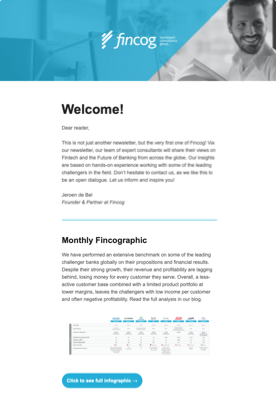After a few years of waiting, the Payment Services Directive 2 (PSD2) went into effect on 13 January 2018. With the introduction of the new regulation, Europe is aiming to drive innovation in financial services and enhance security for customers.
One of the key elements is the Access to Account (XS2A), which allows and regulates third party access to the customer account and its data. This enables two main types of new generic services, namely Account Information Services (AIS, e.g. a financial overview, confirmation of the funds and accountholder identity) and Payment Initiation Services (PIS, eg. Payments by third parties).
For several years PSD2 has been one of the key themes within the financial services industry. One of the main worries of banks was, by giving access to bank’s customer financial data, they’re losing the main customer relationship to new entrants. Thereby losing market share, losing margins and overall becoming less relevant.
However, talking to bankers nowadays there often seems to be some sort of relief that the impact is limited. While we acknowledge differences between the countries (eg. delay of implementation in the Netherlands), the impact seems yet rather meager, only technical and in regulatory compliance. So far, banks still exist and are not losing market share to large newcomers in fintech, big-tech and retailers. Thus it’s all quiet at the PSD2 front.
We believe nevertheless that underneath the surface a change is happening in the market. For instance, banks are moving towards open-banking and are exploring opportunities to capitalize on the infrastructure.
And not only banks and fintechs are actively exploring opportunities, also bigtechs and retailers are very much interested. PSD2 offers a large variety of new opportunities to broaden the service scope to customers, circumvent banks and create new business models. What are the opportunities for them?
PSD2 aims to benefit the consumer, the end-user, with better services. Therefore, a good way to identify new opportunities for retailers is to look at where PSD2 might improve the customer journey, using a customer journey map.
A customer journey map helps to highlight how and where a customer interacts with a company in their buying and user journey. It not only looks at functional steps (eg. going to a shop, comparing prices), but also embraces emotional and social factors (eg. disappointment because long waiting times, confusion from too many choices or too much information, looking at what other people recommend). As such, it can be a useful tool for companies to improve their offering.
To see how the new services of PSD2 can improve a customer journey, we have identified four type of use cases:
1.Omni channel: this use case applies to businesses focussing on getting new customers in an omnichannel environment for whom the overall customer experience is most importante (e.g. consumer electronics). In an Omni channel world, the customer journey is an overlapping set of physical and digital experiences. Customers search on their desktop, go to a shop to see and touch the device, look on their mobile for reviews and return physical at a depot, However, the payment step is still a hurdle. There is no device or payment solution which bridges the channels in a perfect way. Smartphone wallets play an important role in combining physical and digital channels. PIS offers them more ease of use to the customer and a broader reach, while at the same time also lowering their cost of payments.
2. Conversion: for businesses with a focus on getting new customers, the conversion in the buying stage is most important (e.g. e-commerce). The buying stage is all about conversion. Payments is always a balance between paying ‘easy and quick’ and ‘safe and secure’. This results in conversion-killing payment gateways, with a big role for the issuing bank. While it’s still a discussion on how the secured customer authentication within the PIS will be done, this opens the door to new, more convenient payments services by retailers.
3. Loyalty: companies that operate in a highly competitive, high price-transparent market often follow a commercial strategy to bind existing customers with a loyalty program (e.g. airlines, supermarkets). These programs are often not directly linked to the payment step, which limits their scope and functionality. Who want to have an extra loyalty card in their wallet, just for one retailer? Using PIS will link loyalty directly to the payment step, taking away a clear hurdle for loyalty programs. Also, with AIS a retailer will be able to ask more customer information, which creates a richer CRM system, resulting in better offerings to customer and a higher conversion.
4. Data-aggregation: Big data was a big hype a few years ago, PSD2 offers new possibilitues for it. For instance, lets take a business trying to keep existing customers in a market with multiple clear distinct market segments, but low transparency (e.g. car maintenance). Having more customer information results in better visibility of customer behavior and therefore can lower risks in financial products. Therefore, PSD2 can result in taking over entire steps in the customer journey, for instance with plug-and-play financial products. Nowadays many retailers and car manufacturers have their own lending services, onstead of relying on other parties.
As these use cases show, PSD2 enables a variety of new opportunities for both financial- and non-financial companies. All sorts of companies are experimenting with possible use case, following an offensive strategy to open up new market and adding more value to customers. It may take some time for the initiatives to mature, but eventually this will further disintermediate banks and put pressure on margins.
Therefore we believe that, eventhough the impact in the short-term is limited to only compliance, in the long-term it has set a change in the market.


